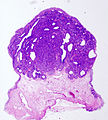Difference between revisions of "Inverted urothelial papilloma"
Jump to navigation
Jump to search
(remove space) |
(→Sign out: +micro) |
||
| (3 intermediate revisions by the same user not shown) | |||
| Line 46: | Line 46: | ||
===Images=== | ===Images=== | ||
====Case 1==== | |||
<gallery> | <gallery> | ||
Image:Inverted_papilloma_high_mag.jpg | Inverted papilloma - high mag. (WC/Nephron) | Image:Inverted_papilloma_high_mag.jpg | Inverted papilloma - high mag. (WC/Nephron) | ||
Image:Inverted_papilloma_intermed_mag.jpg | Inverted papilloma - intermed. mag. (WC/Nephron) | Image:Inverted_papilloma_intermed_mag.jpg | Inverted papilloma - intermed. mag. (WC/Nephron) | ||
</gallery> | |||
====Case 2==== | |||
<gallery> | |||
Image: Bladder inverted papilloma histopathology (1).jpg | IUP. (WC/KGH) | |||
Image: Bladder inverted papilloma histopathology (2).jpg | IUP. (WC/KGH) | |||
Image: Bladder inverted papilloma histopathology (3).jpg | IUP. (WC/KGH) | |||
</gallery> | </gallery> | ||
| Line 59: | Line 66: | ||
==See also== | ==See also== | ||
*[[Urothelium]]. | *[[Urothelium]]. | ||
*[[Urothelial papilloma]]. | |||
*[[Cystitis cystica]]. | *[[Cystitis cystica]]. | ||
==Sign out== | |||
<pre> | |||
Bladder Tumour, Transurthral Resection: | |||
- Inverted papilloma. | |||
</pre> | |||
===Micro=== | |||
The sections show urothelial mucosa with a densely packed urothelial nests with peripheral palisading. The cells of the urothelial nests are bland. Proliferative activity is not apparent. Definite papillae are absent. No exophytic component is apparent. | |||
==References== | ==References== | ||
Latest revision as of 18:41, 7 June 2021
| Inverted urothelial papilloma | |
|---|---|
| Diagnosis in short | |
 Inverted urothelial papilloma. H&E stain. | |
|
| |
| LM | like papillomas... but grow downward; never have an exophytic component; nests have peripheral palisading of nuclei - important |
| LM DDx | low grade papillary urothelial carcinoma with an inverted growth pattern |
| IHC | Ki-67 -ve, CK20 -ve, p53 -ve (rarely +ve) |
| Site | urothelium - usu. urinary bladder |
|
| |
| Prevalence | uncommon |
| Prognosis | benign |
Inverted urothelial papilloma, also inverted papilloma, is a benign urothelial lesion that may be confused with urothelial carcinoma.
General
- May be confused with papillary urothelial carcinoma with an inverted growth pattern.
Microscopic
Features:
- Like papillomas... but grow downward.[1]
- According to THvdK,[2] inverted papillomas never have an exophytic component; if an exophytic component is present it is urothelial carcinoma. This is disputed by one paper from Mexico that examines two cases.[3]
- Nests have peripheral palisading of nuclei - important.
DDx:
- Low grade papillary urothelial carcinoma with an inverted growth pattern.
- Cystitis cystica.
Images
Case 1
Case 2
IHC
May be useful versus inverted growth pattern UCC:[4]
- Ki-67 -ve.
- CK20 -ve.
- p53 -ve (rarely +ve).
See also
Sign out
Bladder Tumour, Transurthral Resection:
- Inverted papilloma.
Micro
The sections show urothelial mucosa with a densely packed urothelial nests with peripheral palisading. The cells of the urothelial nests are bland. Proliferative activity is not apparent. Definite papillae are absent. No exophytic component is apparent.
References
- ↑ Humphrey, Peter A; Dehner, Louis P; Pfeifer, John D (2008). The Washington Manual of Surgical Pathology (1st ed.). Lippincott Williams & Wilkins. pp. 310. ISBN 978-0781765275.
- ↑ THvdK. 21 June 2010.
- ↑ Albores-Saavedra J, Chable-Montero F, Hernández-Rodríguez OX, Montante-Montes de Oca D, Angeles-Angeles A (June 2009). "Inverted urothelial papilloma of the urinary bladder with focal papillary pattern: a previously undescribed feature". Ann Diagn Pathol 13 (3): 158–61. doi:10.1016/j.anndiagpath.2009.02.009. PMID 19433293.
- ↑ Jones, TD.; Zhang, S.; Lopez-Beltran, A.; Eble, JN.; Sung, MT.; MacLennan, GT.; Montironi, R.; Tan, PH. et al. (Dec 2007). "Urothelial carcinoma with an inverted growth pattern can be distinguished from inverted papilloma by fluorescence in situ hybridization, immunohistochemistry, and morphologic analysis.". Am J Surg Pathol 31 (12): 1861-7. doi:10.1097/PAS.0b013e318060cb9d. PMID 18043040.




